S5004022
Coins and potuer in Late Iron Age Britain 38
not gold, was used for the consecradon of kings, for propriating the gods and acting as the supreme standard of value (Herbert 1984). This waming is not mere specula-don; there has been evidence around for years chat the percepdon of the value of metals in the Iron Age might not be quite as it appeared. Haselgrove conducted' a detailed study of the deposidonal context of Iron Age coin in Britain. In this he found strong similarides between the deposidon of early gold and early potin (cast tin-bronze coins). Both were found in hoards and away from settlements, in contrast to later silver and struck-bronze issues which were morę commonly found on setdement sites (Haselgrove 1987). Our modem percepuons of value would like us to rank gold far higher than potin, and many have done precisely that, cquating potin with low-value coinage or ‘small-change’ (e.g. Van Arsdell 19893:7; Cunliffe1 1991:545). But the archaeological similarity between the treatment of gold and podn should caution us strongly about the relative status of the metals around-100 BC.
The problems in transferring value judgements from today into the past go far further than this. By pladng a stress on the propordon of different elements and equadng that with value we may be missing the importance of some of the rather 1 curious changes taking place in the alloys of Gallo-Belgic and Bridsh coin. The first thing to notę is that the idea that there was a consistent chronol ogi cal reducdon in the gold content of staters is an oversimplificadon. In Fig. 2.5 the spread of the alloy j composition of Gallo-Belgic A-E staters is shown. Whilst Gallo-Belgic A-C show a ! uniform trend depicdng a marginal decrease in the gold content over time, Galio- ; Belgie D and E have an extremely varied composidon. Gallo-Belgic D has anything » from c. 47-75 per cent gold, and Gallo-Belgic E is not much different. This singular J variety in alloy composition continued with some of the early Bridsh issues. Bridsh A | varied from c. 42-^71 per cent gold. With such a yariation in gold content, a simple S eąuation of the percentage of gold with perceived value is unlikely.
As Van Arsdell realised (1989^, a key factor in the debasement of these issues was the maintenance of the colour of the alloy. As Fig. 2.5 shows, the specific locadon of these temaiy alloys in the diagram is at the point where the yellowy-golden colour of | the alloy is retained best, despite the reducdon in elemental gold. If slighdy too much 1 silver was added the alloy would become white, and if slighdy too much copper, a 1 reddy-golden colour would result. Indeed for all the early serial imagery coinage in j Britain (Bridsh A-J), the yellowy-golden colour was for some reason important. As we will see, it was only when that serial imagery was revised (Stage 2) that new alloy composidons came in and the colour of the coins began to change, and reddy alloys came to be used.
This immediately tells us something about colour percepdon in the Mid-Late Iron Age. Whilst mostpeople are capable of 6eeing the fuli speetmm of yisible light, not all sociedes conceptualise or appear to nodce all the differences within that rangę. For example, both the Edo and the Kongo of Africa perceived and described the yellowy golden colour of brass as ‘red’. This was not because they could not see a difference, but rather because in thofr conceptual and linguisuc framework yellow was equival-
^^^^^jfljflj0ji6iiig84:295). However here m mia/lia Bruam «urH
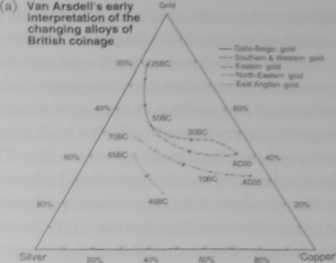
The colour of the Gold
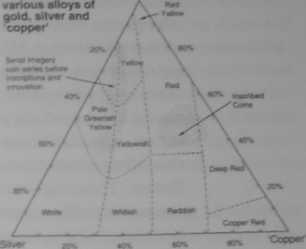
(c) Gallo-Belgic A-E OoU
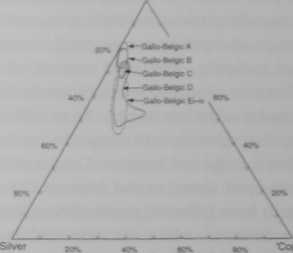
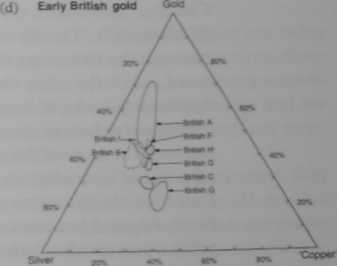
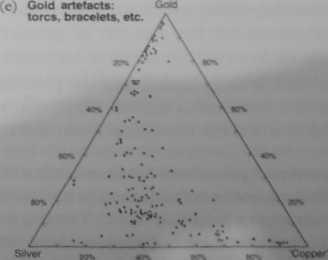
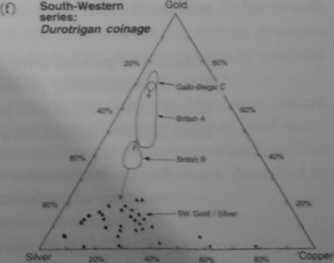
Fig. 2.5 Tematy diagrams: (a) Yan ArsdeU’s vicw (based on Van Arsdell (1989:506) with the tenninol-ogy changed to be consistent with this book); (b) the colour of alloys; (c) ‘Gallo-Belgic’ coins; (d) Early British gold; (c) Gold ancfaca (torcs and biacęłćts, etc.); (f) The South-Westem coin senes. Data from Cowell (1992) and Nonhovcr (1992)
Wyszukiwarka
Podobne podstrony:
S5004029 Coins and potuer in Late Iron Age Britain 52 and some other areas have only gone so far as
46870 S5004024 Coins and power in Late Iron Age Britain 42 This effect was the primary driving lorce
S5004027 Coins and power in Late Iron Age BritainThe various stages of t rance imagery Coins and pow
S5004023 Coins and power in Lata Iron Age Britain 40 to have been taken over the colour of the early
S5004025 m Coins and potoer iti Late Iron Age Britain 44 represented at female pub
więcej podobnych podstron